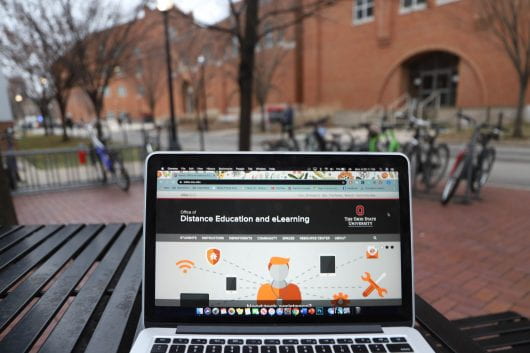
Ohio State’s online undergraduate program is ranked No. 1 by U.S. News & World Report. Credit: Amal Saeed | Photo Editor
Ohio State is often known for its success on the football field, but recognition has expanded to its online classroom.
Seven years after the creation of the Office of Distance Education and eLearning, Ohio State’s online undergraduate program was ranked No. 1 in the nation by U.S. News & World Report this month. Despite the recognition, the program is still seeking to improve.
Robert Griffiths, associate vice president for distance education, said that prior to ODEE’s creation, the university had a small online presence. Griffiths said the success is because of the continued focus on quality despite the quick growth.
Griffiths said the online program has grown because of key leaders early on in the program and the online nursing program, engineering courses and food and agricultural courses paving the way for other colleges’ success. The success from the three colleges led others at the university to explore how online programs can expand their curricula, audience and course reach.
Enrollment in the most popular online courses surpassed Ohio State’s 2015 projection for total online enrollment in 2020: The university predicted 2,100 students would enroll in online courses, according to ODEE’s website. In the university’s three most popular courses, 2,823 total students enrolled.
Griffiths said the most popular online course at Ohio State in fall 2019 was Wine and Beer in Western Culture with 784 students.
According to the Department of Food Science and Technology’s website, the course teaches the role of wine and beer in western culture while emphasizing the geographic origins, production techniques and stylistic considerations.
Griffiths said the second-most popular online course this past fall was Medical Terminology for Health Professions with 634 students.
The course description states that the class teaches terminology and abbreviations pertaining to anatomy, physiology, pathology, diagnostic processes and procedures and medical and surgical interventions by body system.
The third-most popular online course in fall 2019 was the Science of Human Nutrition with 562 students, Griffiths said.
The class teaches basic principles of biological science and emphasizes the interaction between nutrients and physiological processes, according to the course description.
U.S. News & World Report reported that Ohio State’s No. 1 ranking was largely due to the nursing, health sciences and dental hygiene programs. Griffiths said nursing accounts for two of the three most popular online programs the university offers.
The RN to BSN program was the second-most popular online program in fall 2019 with 242 students, and the master’s in nursing was the third-most popular with 216 students, Griffiths said.
Griffiths said the most popular program was the Master of Social Work with 385 students.
Jessica Krok-Schoen, assistant professor at the School of Health and Rehabilitation Sciences, said the programs are constantly improving.
Professors in health sciences host trainings for one another and use resources from ODEE, Krok-Schoen said. They also attend trainings and learn the latest apps and Carmen skills.
“[ODEE] always come up with new ways to engage students online and even in the classroom,” Krok-Schoen said.
ODEE has a team of instructional designers to help faculty who teach online programs, Griffiths said. Each instructional designer is paired with a faculty member to help put a course online and look for opportunities to improve the course.
Griffiths said ODEE is focusing on improving online course development, instructor presence and engagement to promote peer-to-peer connections and create effective structures and communication to help support students as they navigate the course. Ohio State is starting to venture into the next phase of online education and improvement is not a question of content, but of technology.
Online education is moving toward 360-degree video, augmented reality and virtual reality, Griffiths said.
“If you’re thinking online education is sitting behind a keyboard and a screen and passively receiving content, that’s not the direction that online education is going,” he said.


